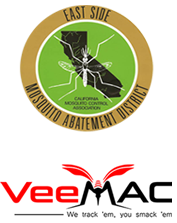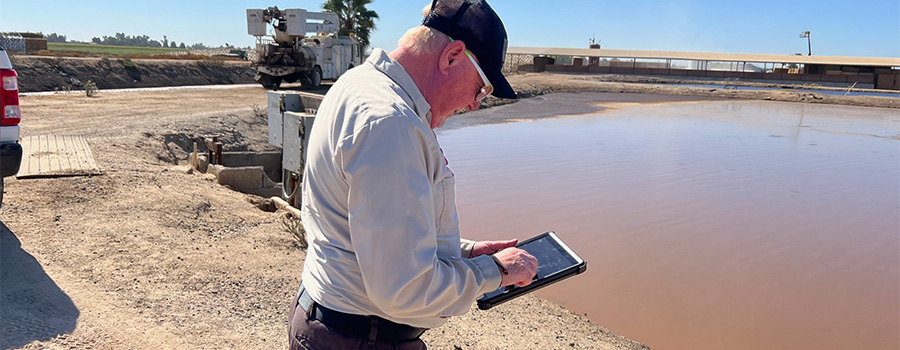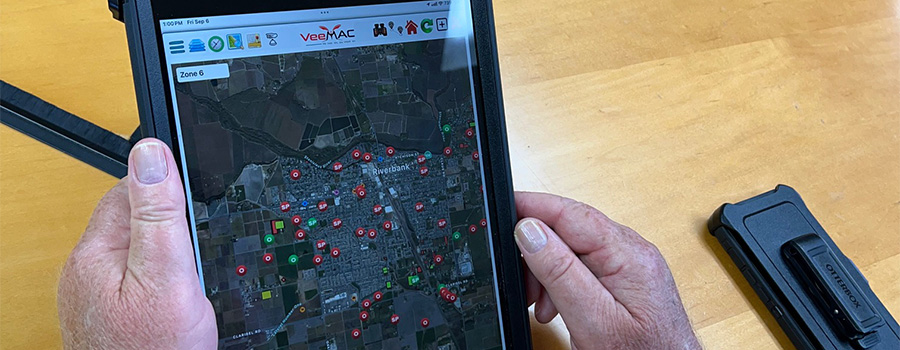East Side Mosquito Abatement District battles mosquitos with technology
Innovative solution combines iPads with special software and Verizon connectivity.
It’s an ancient struggle—man versus mosquito. Nuisance mosquitos plague the outdoors in summertime, particularly at dusk, when they’re most active and looking for food (e.g., blood). Other types of mosquitos carry potentially deadly diseases, including West Nile virus, equine encephalitis and dengue fever. In fact, mosquitos are considered the deadliest creatures in the world, causing more than 1 million deaths annually.1 Whether mosquitos are a nuisance or deadly, getting rid of them requires difficult field work. Now a visionary team in central California is fighting back with an innovative solution that accelerates mosquito abatement and protects public health—all while raising efficiency and cutting costs.
Located near Modesto, California, the East Side Mosquito Abatement District encompasses approximately 540 square miles of residential areas and farmland, including much of Stanislaus County. Like all Special Districts in California, it was created and funded by community residents to provide new or enhanced services—in this case, reducing the mosquito population. Its stated mission is “to serve and protect the public from mosquitos and vector-borne diseases with innovative practices to enhance the quality of life.” But when the District was founded in 1939, there was no way its founders could envision the range of innovative practices implemented by the current leadership.
When Dr. Wakoli Wekesa became district manager in 2019, much of the work in the East Side Mosquito Abatement District was still done on paper—including tracking which areas of the large district had been treated with mosquito-killing materials, when they were treated and whether the treatment was effective. The paper-based system was inefficient, incomplete and difficult to manage. So, Dr. Wekesa moved quickly to bring used laptops to the District and began to transition his team into the digital era.
Fast forward a couple of years. Now all work done by the District’s 18 members is tracked via an innovative solution from VeeMAC, a leader in vector control and management software. The District’s technicians in the field rely on Apple laptops and iPads that run the software, which meticulously tracks what they’ve done, where and when. Verizon Mobile Device Management (MDM) updates and manages these devices, while reliable Verizon wireless connectivity keeps these devices connected to each other and District headquarters.
Dr. Wekesa and his team have worked hard to reduce the mosquito population, boost public comfort and safety, and cut daily requests for mosquito abatement tenfold. By increasing productivity, they’re using their time efficiently and wisely, focusing on tasks that make a difference and treating specific areas more precisely. As a result, they’ve cut their use of mosquito-fighting chemicals in half, saving more than $250,000 annually, along with lowering fuel costs.
The bottom line? The District’s mosquitos are losing while its citizens are winning—with conditions that are safer and more comfortable—and a mosquito-fighting team that’s more efficient and effective than ever. “Yes, the new solution has helped us quite a bit,” says Dr. Wekesa. “We’ve definitely improved how we control and reduce our mosquito population.”

Monitoring and treating mosquito breeding habitats
Getting rid of mosquitos isn’t a one-time battle—it’s an ongoing war. The enemy? Stagnant water where mosquitos breed and larvae thrive. To reduce the mosquito population, water-holding areas, such as culverts, ponds and abandoned swimming pools, need to be drained or treated with larvae-killing materials.
It’s hard, soggy work. And it needs to be carefully controlled. Killing adult mosquitos relies on fogging—spraying of targeted insecticides. The application rate of insecticides needs to be carefully followed so that livestock and pollinators (including the bees vital to agriculture) aren’t harmed.
Even if a fogging application is successful, it’s just the beginning. The application process has to be repeated regularly, since mosquitos aren’t completely eliminated by fogging, just reduced. Tracking what areas have been treated is a major challenge, particularly for large, diverse geographies. And areas that are deemed sensitive, whether residential or agricultural, need to be carefully avoided.

The new solution has helped us quite a bit. We’ve definitely improved how we control and reduce our mosquito population.
Dr. Wakoli Wekesa, District Manager of East Side Mosquito Abatement District
A major upgrade of abatement technology
Dogged by a high volume of resident complaints and driven by visionary new leadership, the District moved from a decidedly low-tech approach to an innovative solution in just a few short years. This solution relies on three main components:
- Advanced Software from VeeMAC. A highly specialized challenge requires an equally specialized solution. VeeMAC, a leader in vector management and control, demonstrated its software capabilities to Dr. Wekesa in 2020, then quickly moved on to testing and full production. The solution’s extensive capabilities start with detailed, GPS-driven maps of the District, featuring color-coded overlays indicating specific areas where larval mosquitos have been detected, areas that have been fogged, areas to be avoided (e.g., geo-fenced) and other key zones. Input from the field via VeeMAC Mobile—and identified precisely via GPS data—updates the maps. From District headquarters, the VeeMAC software enables Dr. Wekesa to monitor progress, adjusting plans and priorities as needed.
- Apple iPads, Laptops and iPhones. The District started its transition from a paper-based documentation with used laptops. Now its field staff uses cellular connected Apple iPads and laptops to track and coordinate progress. And iPhones keep the entire district connected, even when scattered geographically.
- Verizon Wireless Connectivity and Device Management. Verizon connectivity allows real-time data from the field to be shared with other devices on the system in seconds. “With the cellular connection on the iPad coupled with reliable Verizon connectivity, users get internet access so anything done in the field can be reflected in the District office, immediately,” says Steve Fry, co-founder of VeeMAC. “Now everyone can see exactly what the whole team is doing, and track progress.” The solution can also run in a disconnected mode, which queues data until users return to the network, then shares the data with its server and distributes it to all devices on the system.
Verizon Mobile Device Management (MDM) enables the District to push the VeeMAC solution, including regular upgrades, to all of its devices. This cloud-based platform features flexible, customer-defined policy management functions that cover a variety of settings, all to help manage mobile devices—safely and securely. The District, aided by Verizon support personnel (when necessary), can quickly and easily manage its growing number of devices.

Comfort, safety and vigilant ongoing protection
The core benefit this new solution brings to the East Side Mosquito Abatement District is clear—fewer mosquitos annoying residents and potentially spreading disease. But behind that impressive, difficult-to-achieve result, there are many other benefits:
- Higher productivity. By moving from a no/low tech working environment to connected laptops, tablets and smartphones, the District can monitor and control more mosquito breeding sources, more efficiently. Putting technology in the hands of all workers empowers them and lets them use their time better, focusing on high-return efforts. For a small team fighting mosquitos in a District that covers 500+ square miles, greater productivity and higher visibility are major advantages. “Apple iPads and iPhones are revolutionizing what we can do in the field,” says Dr. Wekesa. “Now we can respond in a more timely, responsive manner.”
- Clear, reliable communication throughout the district. With Verizon connectivity via laptops, tablets and smartphones, District personnel can stay closely connected while in the field or in the District office. They can share information, chart progress and coordinate mosquito mitigation efforts.
- Better tracking. Mosquito abatement efforts are now informed by detailed GPS-driven geographical and treatment data—all presented by the VeeMAC software in clear, colorful visual overlays. The VeeMAC solution captures the entire district and the detailed treatment record. Users can see what areas were treated and when the treatments occurred— whether sprayed by vector control technicians with backpack sprayers, by truck or via aircraft.
Armed with these insights, the District leadership can make better, more informed decisions about where to focus its efforts. “There’s no more flying blind,” says Dr. Wekesa. “At the locations our people are treating, they have a record of a month, two months or a year ago. So, they know what they need to do—right now. There’s great value in this historical record when fighting mosquitos.” - More controlled operations. Mosquito abatement chemicals must be applied carefully, in the right amounts and at the right times. The VeeMAC system enables more precise control over fogging by careful GPS tracking of areas that have been treated, reducing over- or under-treatment. For example, when fogging via truck, the VeeMAC ULV Controller—working with the VeeMAC Mobile solution running on an iPad— connects directly to the truck’s material pump to provide an efficient, precise, variable-speed spraying solution. The software controls the speed of the pump based on the chosen apply rate (the amount of chemical materials to apply), the pump’s throughput capacity and the speed of the vehicle. As a result, the right amount of chemicals is applied—and sensitive areas avoided—reducing chemical costs while helping protect sensitive areas.
- Lower cost of materials. The chemicals and other materials used to fight mosquitos are expensive. In the past, the District spent $465,000 annually on these materials. Now, thanks to more efficient tracking and application, it has cut its budget by more than half, to $215,000 over the past three years. Associated costs, such as gas for trucks and airplanes, are also lower.
- Higher morale. The work of the District is hot, uncomfortable, difficult and repetitive, even during the best of times. But knowing that their efforts are paying off makes the hard work seem much more worthwhile—and raises morale. “I think that our staff is actually enjoying doing even the hardest work, since they’re seeing progress—and always learning something new,” says Dr. Wekesa. “The work environment is quite improved by the new solution.”
- Better quality of life. Residents within the district used to call in with complaints about mosquitos. At times, the volume of calls totaled as much as 256 calls a day, including schools pleading for attention. Although the arrival of the Aedes agypti mosquito in Modesto has heightened public anxiety, on a recent day, the incoming calls totaled sixteen, according to Dr. Wekesa. “Kids can play outside because now we know where the problem areas are before the problems happen. With the new solution, we’re able to stay on top of the mosquito problem.” Armed with more data, the District can shift its efforts from reactive attempts to battle adult mosquitos to more effective efforts to proactively destroy mosquito larvae where they live, in culverts, agricultural canals and other areas where water gathers. These areas are also visually highlighted and tracked by the VeeMAC software.
- Lower public health risk. While the vast majority of the District’s mosquito population can be categorized as nuisance mosquitos, fewer mosquitos mean lower risk of mosquito-borne illnesses. As conditions shift, the risk of disease transmission via mosquitos can rise—and the District is ready.
When you’re doing something new, you have to rely on your team. We have Verizon, Apple and VeeMAC to thank for this solution.
Dr. Wakoli Wekesa, District Manager of East Side Mosquito Abatement District
Continuing the good fight against a bad insect
“When you’re doing something new, you have to rely on your team,” says Dr. Wekesa. “We have Verizon, Apple and VeeMAC to thank for this solution.” The ultimate beneficiaries? The citizens of the District, who now have a more comfortable, safer environment. What’s ahead? More devices, deeper knowledge, greater automation—and an even lower mosquito population.
Learn more
To find out more about Verizon Public Sector solutions, visit: verizon.com/publicsector.
To find out more about Verizon Connect Reveal, visit: verizonconnect.com.
1 “Deadliest Animals Worldwide,” Statista, 2022. https://www.statista.com/statistics/448169/deadliest-creatures-in-the-world-by-number-of-human-deaths/.